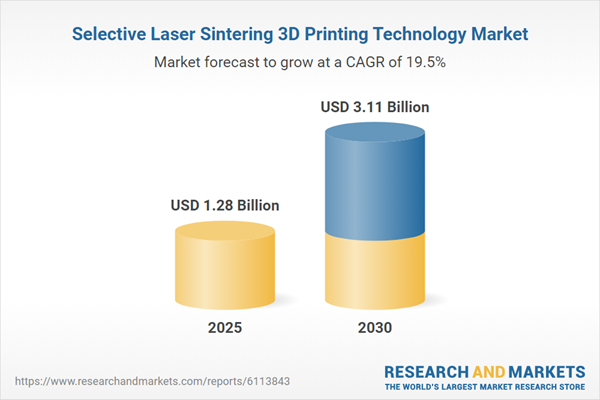Selective laser sintering (SLS) is a 3D printing technology that employs a high-powered laser to fuse small particles of plastics or ceramics, creating precise, complex 3D objects. Widely used for prototyping and hobbyist projects, SLS is gaining traction in industries such as aerospace and healthcare due to its ability to produce intricate, durable components. The global adoption of 3D printing solutions is expected to drive significant demand for SLS technology during the forecast period (2024 onward). Key growth drivers include its increasing application in aerospace for lightweight, high-stability components and in healthcare for surgical tools, guides, and prosthetics. However, competition from alternative 3D printing technologies may pose challenges to market expansion.
Market Drivers
Aerospace Industry Applications
SLS 3D printing is highly valued in the aerospace sector for its geometric design freedom, enabling the production of complex, lightweight, and stable components at reasonable unit costs. This makes it ideal for small-batch production of parts such as heat-resistant engine components (e.g., tarmac nozzle bezels) and flexible air ducts (e.g., airflow ducting and bellow directors). The aerospace and defense industry’s steady growth is expected to bolster demand for SLS technology. The increasing need for advanced manufacturing solutions in aerospace, driven by the industry’s focus on precision and efficiency, is projected to significantly propel the SLS market forward during the forecast period.Healthcare and Prosthetics
SLS technology is increasingly utilized in healthcare, particularly for creating surgical learning tools, guides, and prosthetics. Its ability to produce parts with a bone-like surface finish and superior strength makes it ideal for replicating anatomical models and surgical guides, which enhance the precision of procedures like screw and plate placement, leading to improved postoperative outcomes. The technology’s capacity to fabricate complex geometries is critical for prosthetics, which require customized designs tailored to individual needs. SLS is especially effective for the interface sections of functional prosthetics due to its precision and durability. The rising prevalence of prosthetics, driven by an aging population, increasing sports injuries, and technological advancements, is expected to further boost the SLS market in the coming years.Market Challenges
The availability of substitute 3D printing technologies, such as fused deposition modeling (FDM) or stereolithography (SLA), presents a significant challenge to SLS market growth. These alternatives may offer lower costs or different material compatibility, potentially diverting demand from SLS in certain applications. Additionally, which reduced demand in key end-use industries like automotive and aerospace and delayed elective surgeries, thereby decreasing the need for SLS-produced surgical tools and guides.Geographical Outlook
North America
North America is expected to maintain a significant share of the SLS 3D printing market during the forecast period, driven by its advanced healthcare system and robust aerospace and automotive industries. The region’s healthcare sector extensively employs SLS for surgical guides and tools, benefiting from the technology’s precision and reliability. The steady growth of the aerospace industry, with its demand for lightweight and durable components, further supports market expansion. Investments in advanced manufacturing and a strong innovation ecosystem position North America as a key market for SLS technology.Asia Pacific
The Asia Pacific region is projected to experience the highest growth in the SLS 3D printing market, fueled by the rapid expansion of its manufacturing sector. The region’s increasing focus on advanced manufacturing technologies and growing industrial base create significant opportunities for SLS adoption. The rise in manufacturing activities, coupled with investments in aerospace and healthcare, is expected to drive demand for SLS technology, making Asia Pacific a critical growth region during the forecast period.Key Benefits of this Report:
- Insightful Analysis: Gain detailed market insights covering major as well as emerging geographical regions, focusing on customer segments, government policies and socio-economic factors, consumer preferences, industry verticals, and other sub-segments.
- Competitive Landscape: Understand the strategic maneuvers employed by key players globally to understand possible market penetration with the correct strategy.
- Market Drivers & Future Trends: Explore the dynamic factors and pivotal market trends and how they will shape future market developments.
- Actionable Recommendations: Utilize the insights to exercise strategic decisions to uncover new business streams and revenues in a dynamic environment.
- Caters to a Wide Audience: Beneficial and cost-effective for startups, research institutions, consultants, SMEs, and large enterprises.
What do businesses use our reports for?
Industry and Market Insights, Opportunity Assessment, Product Demand Forecasting, Market Entry Strategy, Geographical Expansion, Capital Investment Decisions, Regulatory Framework & Implications, New Product Development, Competitive IntelligenceReport Coverage:
- Historical data from 2022 to 2024 & forecast data from 2025 to 2030
- Growth Opportunities, Challenges, Supply Chain Outlook, Regulatory Framework, and Trend Analysis
- Competitive Positioning, Strategies, and Market Share Analysis
- Revenue Growth and Forecast Assessment of segments and regions including countries
- Company Profiling (Strategies, Products, Financial Information, and Key Developments among others).
Segmentation:
By Component
- Hardware
- Software
- Services
- Material
By End-Use Industry
- Healthcare
- Automotive
- Aerospace and Defense
- Others
By Geography
- North America
- USA
- Canada
- Mexico
- South America
- Brazil
- Argentina
- Others
- Europe
- Germany
- France
- UK
- Others
- Middle East and Africa
- Saudi Arabia
- UAE
- Others
- Asia Pacific
- China
- India
- Japan
- South Korea
- Taiwan
- Thailand
- Indonesia
- Others
Table of Contents
Companies Mentioned
- Formlabs, Inc.
- PRODWAYS GROUP
- 3D Systems, Inc
- Proto Labs, Ltd.
- Stratasys Ltd.
- EOS GmbH
- Shining 3D
- XYZprinting, Inc. (New Kinpo Group)
- Shenzhen Dazzle Laser Forming Technology Co., Ltd.
- Proto3000
Table Information
| Report Attribute | Details |
|---|---|
| No. of Pages | 145 |
| Published | June 2025 |
| Forecast Period | 2025 - 2030 |
| Estimated Market Value ( USD | $ 1.28 Billion |
| Forecasted Market Value ( USD | $ 3.11 Billion |
| Compound Annual Growth Rate | 19.4% |
| Regions Covered | Global |
| No. of Companies Mentioned | 10 |









